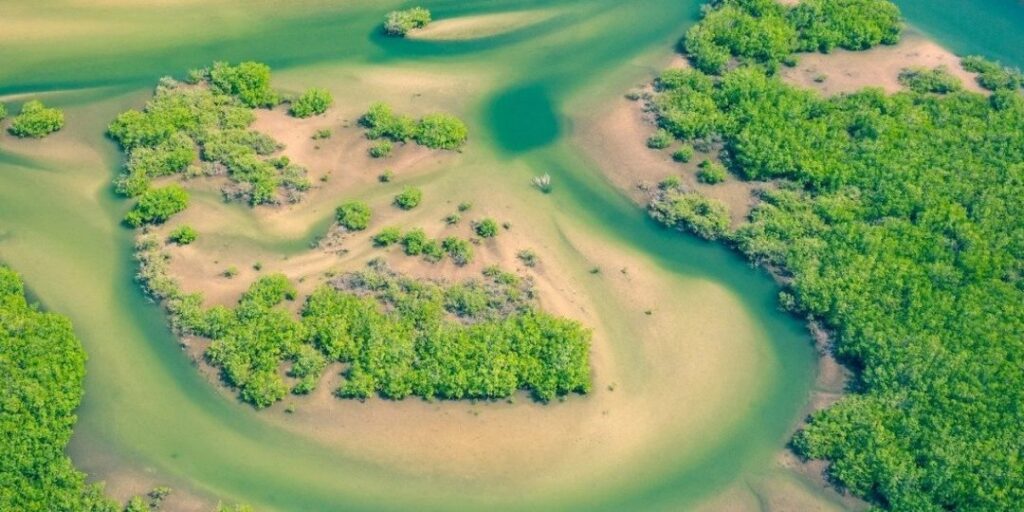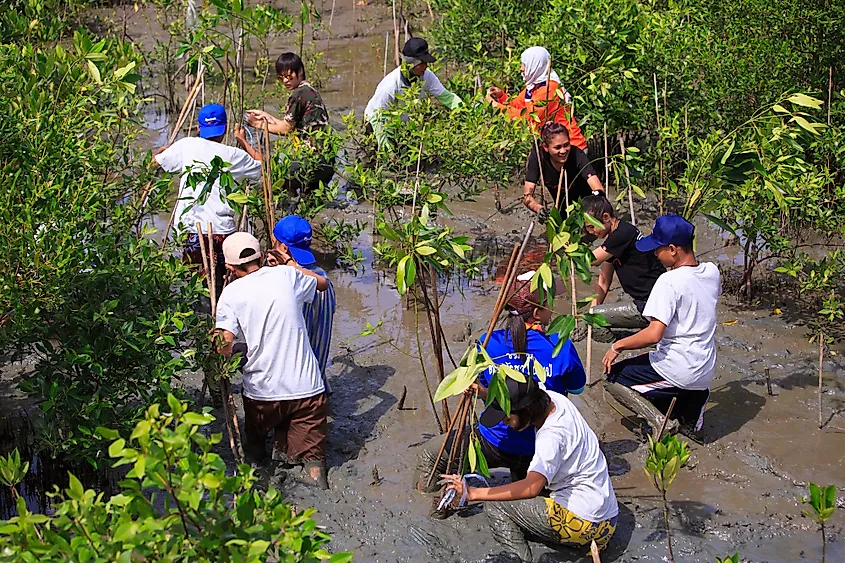

When you think of Tanzania, images of vast savannahs teeming with wildlife and the iconic Serengeti come to mind. However, nestled along Tanzania’s stunning coastline lies a hidden gem that offers a unique and enriching experience for nature enthusiasts—the magnificent mangroves. Embarking on a safari with Future African Safari means uncovering these coastal treasures, where lush greenery meets vibrant marine life. Join us as we explore Tanzania’s mangroves and discover why they should be a highlight of your African adventure.

What Are Mangroves?
Mangroves are unique coastal ecosystems characterized by their dense, tangled root systems and ability to thrive in saline, waterlogged environments. These vital habitats are found in tropical and subtropical regions around the world, and Tanzania boasts some of the most pristine mangrove forests in East Africa.
- Adapted Flora: Mangrove trees are specially adapted to survive in harsh coastal conditions. Their intricate root systems provide stability against strong ocean currents and tides, while their aerial roots allow for gas exchange in oxygen-poor soils.
- Biodiverse Habitat: Mangroves support an incredible diversity of life, serving as nurseries for many marine species and providing shelter for a variety of birds, reptiles, and mammals.
Where to Find Tanzania’s Mangroves
Tanzania’s coastline stretches over 1,424 kilometers (884 miles) along the Indian Ocean, offering several key areas where mangroves flourish:
- Mtwara Region: Known for its rich mangrove forests, the Mtwara coastline is a prime location for exploring dense mangrove ecosystems.
- Tanga Region: Home to the Tanga Bay mangroves, this area is renowned for its extensive root systems and diverse wildlife.
- Zanzibar Archipelago: The islands of Zanzibar feature vibrant mangrove forests that contribute to their unique charm and biodiversity.
Biodiversity in the Mangroves
Tanzania’s mangroves are teeming with life, making them a paradise for biodiversity enthusiasts:
- Marine Life: Mangroves serve as nurseries for numerous fish species, including sardines, mullets, and snappers. They also provide feeding grounds for crustaceans like crabs and shrimp.
- Birdwatching Haven: The mangrove forests are a haven for birdwatchers, hosting species such as kingfishers, herons, and the elusive mangrove whimbrel.
- Reptiles and Mammals: Spot reptiles like the mangrove snake and mammals such as the red colobus monkey and various bat species.
- Flora Diversity: Beyond mangrove trees, these ecosystems are home to a variety of plant species, including reeds, grasses, and flowering plants that add to the lush greenery.
Activities to Enjoy in the Mangroves
Exploring Tanzania’s mangroves offers a range of activities that cater to different interests and adventure levels:
1. Kayaking and Canoeing
Glide through the serene waterways of the mangroves by kayak or canoe. This tranquil activity allows you to intimately observe the unique flora and fauna, navigate through narrow channels, and enjoy the peaceful ambiance away from the bustling tourist trails.
2. Boat Safaris
Join a guided boat safari to explore the expansive mangrove forests. Knowledgeable guides will lead you through the intricate waterways, pointing out hidden wildlife and explaining the ecological significance of the mangroves.
3. Birdwatching Tours
With their rich avian diversity, mangroves are perfect for birdwatching enthusiasts. Early morning tours offer the best chances to spot a variety of bird species in their natural habitat, capturing stunning photographs of their vibrant colors and behaviors.
4. Nature Walks
Embark on a guided nature walk through the mangroves to discover the intricate ecosystem up close. Learn about the adaptations of mangrove plants, the roles of different species, and the importance of mangroves in coastal protection and carbon sequestration.
5. Cultural Experiences
Engage with local communities that live alongside the mangroves. Learn about traditional fishing practices, artisanal crafts, and the cultural significance of mangroves to the coastal people of Tanzania.
Conservation Importance of Mangroves
Mangroves play a critical role in environmental conservation, and their preservation is vital for maintaining ecological balance:
- Coastal Protection: Mangroves act as natural barriers against storm surges, erosion, and rising sea levels, protecting coastal communities and infrastructure.
- Carbon Sequestration: These ecosystems are highly efficient at capturing and storing carbon dioxide, helping to mitigate climate change.
- Biodiversity Support: Mangroves provide essential habitats for a wide range of species, contributing to overall biodiversity and ecosystem resilience.
- Water Quality Improvement: Mangrove roots filter pollutants and sediments from water, maintaining the health of coastal and marine environments.
Conservation Efforts in Tanzania
Tanzania is dedicated to preserving its mangrove ecosystems through various initiatives and collaborative efforts:
- Protected Areas: Many mangrove forests are designated as protected areas within national parks and reserves, ensuring legal protection and dedicated conservation resources.
- Community-Based Projects: Involving local communities in conservation efforts fosters sustainable practices and empowers them to become stewards of their natural heritage.
- Research and Education: Ongoing research projects monitor mangrove health, biodiversity, and the impacts of climate change, while educational programs raise awareness about the importance of mangrove conservation.
- Reforestation Initiatives: Efforts to restore degraded mangrove areas through reforestation and habitat restoration help enhance ecosystem services and biodiversity.
Tips for an Eco-Friendly Mangrove Safari
Enhance your mangrove exploration with these eco-friendly tips:
- Respect Wildlife: Observe animals from a distance and avoid disturbing their natural behaviors. Use binoculars or cameras with zoom lenses for closer views.
- Minimize Impact: Stick to designated paths and avoid trampling vegetation. Take all trash with you to keep the mangroves pristine.
- Support Local Conservation: Choose tour operators that prioritize sustainable practices and contribute to local conservation projects.
- Stay Informed: Learn about the ecological importance of mangroves and the threats they face, fostering a deeper appreciation and commitment to their preservation.
Plan Your Mangrove Adventure with Future African Safari
Exploring Tanzania’s mangroves offers a unique and enriching dimension to your safari experience, blending adventure with conservation and cultural immersion. At Future African Safari, we specialize in crafting personalized itineraries that include the best mangrove destinations, ensuring a memorable and sustainable adventure.
- Expert Guides: Our knowledgeable guides provide insightful commentary and ensure your visit is both educational and respectful to the environment.
- Customized Itineraries: Whether you seek tranquility, wildlife encounters, or cultural experiences, we tailor your mangrove safari to meet your interests and preferences.
- Sustainable Practices: We prioritize eco-friendly tourism, using sustainable transportation options and supporting local conservation efforts to minimize our environmental footprint.
Ready to explore Tanzania’s hidden coastal treasure? Contact Future African Safari today to customize your mangrove safari and embark on an adventure that celebrates the beauty, diversity, and importance of Tanzania’s enchanting mangrove ecosystems.
Explore more about our safari packages and discover the best of Tanzania with Future African Safari. Your unforgettable African adventure starts here!

